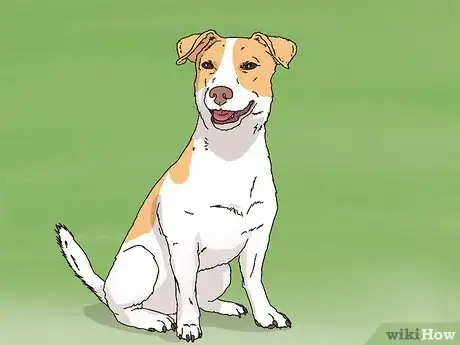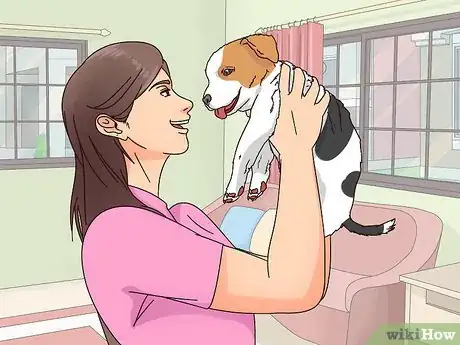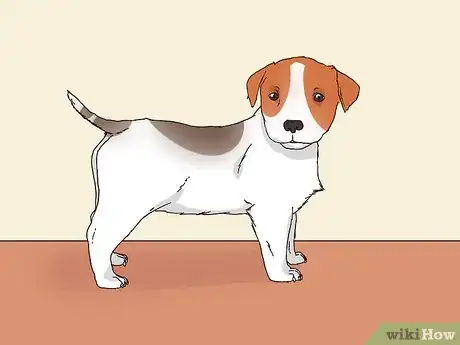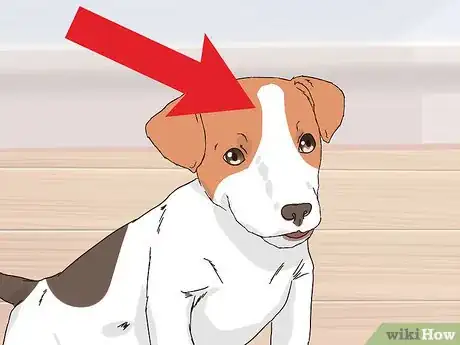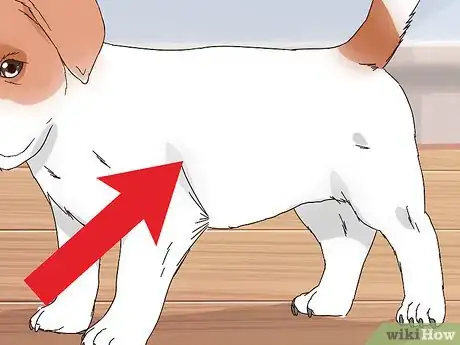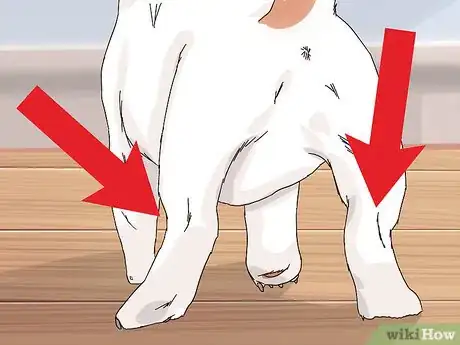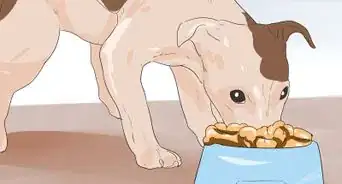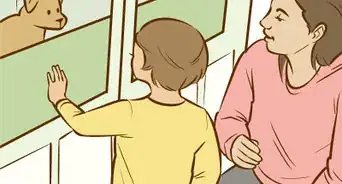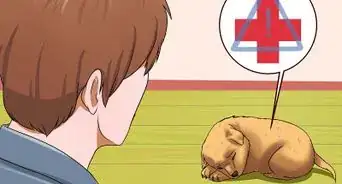This article was co-authored by Jennifer Schneider. Jennifer Schneider is a Dog Behavior and Training Expert, as well as the Owner of Pick of the Litter Dog Training. With over 25 years of experience, she specializes in positive, dog-friendly training. She holds a BA in Psychology with an Emphasis on Animal Behavior from the University of Washington, and she’s a Certified Professional Dog Trainer (CPDT).
wikiHow marks an article as reader-approved once it receives enough positive feedback. In this case, 100% of readers who voted found the article helpful, earning it our reader-approved status.
This article has been viewed 264,206 times.
Jack Russell Terriers are energetic and fun dogs that can be a great addition to your family; however, they take a lot of time and energy to raise properly, and have certain characteristics that do not make them suitable for every home. For instance, they can be more prone to aggression than other breeds. In addition, they are very energetic and strong-willed, so they need an experienced handler to control their willful behavior and prevent them become aggressive. If you think you can provide a good home for this working breed, make sure you choose the right puppy. Evaluate how the puppy fits the breed standards, check the puppy's personality, and investigate your potential breeder before you decide on the puppy that's right for you and your family.
Steps
Assessing the Personality of a Jack Russell Puppy
-
1Know the personality of the Jack Russell Terrier. You should know what you will be getting into when you decide to adopt a Jack Russell, to make sure the breed and your lifestyle are suitably matched.
- Jack Russell Terriers tend to believe they are a lot bigger than they actually are. This means that they may tend to take on dogs that are bigger than them.
- Jack Russells can be more prone to aggression than other breeds because instinctively they attack, rather than back down, when frightened.
- They are one of the most enjoyable, intelligent, and stimulating breeds you could hope for; however, they are working dogs and very energetic, requiring lots of stimulation mentally and physically. This is not a good dog for an apartment or if you are gone for long periods of time.
- The Jack Russell Terrier is a willful breed that is going to need a lot of training. Your puppy will require training from the very beginning, especially with learning not to snip, to be patient and stay still or relaxed, and to listen and obey. Your household must be ready for the tornado to descend, so to speak.
- They also have a very high prey drive and do not make good pets in a household with cats or other small mammals, as they will chase and harm the other pets.
- Jack Russell Terriers need to be occupied or they will get into trouble. They do well with any activity, including agility competitions, dog shows, obedience training, tracking, flyball, or disc sports.
- They are great companions and tend to be good with children as long as the children treat the dog well, as they are not very patient with mishandling.
-
2Look for an alert, active and lively puppy. The animal's disposition should be fearless and happy. A Jack Russell should be confident, but not overly aggressive. Consider those that appear happy, energetic and bold, without being a bully or picking on their litter mates.[3]
- Traits undesirable in a Jack Russell Terrier include nervousness and cowering, as they will be more likely to bite when they are scared and they will not be suited for companionship or athleticism.
- Avoid puppies that appear disinterested, sluggish, or weak, as these could be signs of unhealthiness.
Advertisement -
3Watch how the puppy responds to your family members. If the puppy is very excited and responsive to all members of your household, then it will likely be a good match. There is something to be said for dogs picking their owners, just as much as owners pick their dogs.
- If the puppy doesn’t come to you, even when encouraged, it may not be the right one for you.
Checking the Physical Traits of a Jack Russell Puppy
-
1Observe the puppy's build, which should be sturdy and solid. Even as a puppy, the Jack Russell's height and length should be in proportion with one another, and the dog should appear well-balanced. Jack Russell Terriers are slightly longer than they are tall.
- Avoid those that are thinly muscled, bony, or have a potbelly appearance, as these can be signs of a medical issue or malnutrition.
- They are usually 10 to 12 inches tall and generally weigh between 12 and 15 pounds. Some are smaller or larger, depending on how they are bred, or if they are mixed with another breed.[4]
-
2Check the shape of the puppy's skull, which should be flat. According to breed standard, the Jack Russell's head should be of medium width at the ear, narrow slightly at the eyes, and flare out again at the muzzle.[3]
- The dog's nose should be black and his jaw should have strong cheek muscles. The puppy's eyes should be dark brown to black and almond-shaped.
- The ears fall forward close to the dog's head and are v-shaped. Their ears should be very mobile, coming forward and together when the dog’s head is alert. (Puppy’s ears get more mobile as they get older, so you may not see much in the movement of the ears at a very young age.)
- The top jaw should overlap the lower jaw slightly, but with the bottom puppy canines being in front of the upper canines when the mouth is fully closed. The rear chewing teeth of the upper jaw should line up and be just outside the chewing teeth of the lower jaw.
-
3Look at the puppy's body, checking for typical and desirable characteristics. Be sure the puppy's neck has clean, muscular lines and widens gradually at the shoulders, which should slope. The front legs must be straight and strong with the joints aligned.
- Jack Russells were originally bred for fox hunting, to go into the fox’s den and root them out. They were bred to be fearless hunters and to have a very muscular, lithe body perfect for getting into tight quarters.
- The puppy should have a chest that is longer than it is wide, with a body that appears generally athletic.
- Check for a straight, strong back and a loin (lower back from the back of the ribs to the upper part of the rump) that is short and well-muscled.
-
4Look at the puppy's hindquarters. The hocks, which are the joints at the back of the rear legs, should be straight from the joint to the back of the foot. From the rear, the Jack Russell should present a strong, muscular appearance, with well-rounded buttocks and thighs.
- The feet should point straight forward (turning neither in nor out), and should be round and well-padded.
- The tail should be about 4 inches (10.2 cm) long, carried merrily and set high on the hindquarters. If docked, the tail will be on the same level as the ears. The tail may droop at rest, but will be erect when moving.
-
5Take note of the appearance of the puppy's coat. If the animal is smooth-coated, make sure there are no thin spots. Rough or broken-coated Jack Russell should not appear woolly. The coat should be at least 70 percent white. Acceptable colors for markings are tan, black or brown, but not brindle.
- If the puppy’s coat is dry and flaky, doesn’t return to its normal position when pinched up at the neck, or is overall thin or with thin areas, it may have a medical issue.
-
6Watch the Jack Russell puppy's movements closely. Its gait should be well-coordinated and lively. Many young puppies will be clumsy and fall over, a little more hesitant about heights or new objects, and oftentimes their head will be heavier than their back end when they are eating and drinking.
- However, puppies should not have any limbs that don’t move forward and back correctly, should not fall over during normal walking, and should not have tremors to their head and neck when trying to eat or drink. These can be signs of neurologic disease in the puppy.
Finding a Puppy From a Good Source
-
1Know where to get a good puppy. There are unfortunately more ‘bad’ breeders out there (breed bad genetics, puppy mills that breed for money, breed because they didn’t spay or neuter their animals appropriately, etc.) than good ones.
- If you are going to a breeder, ask for references they can talk to of other people who have bought from them. Talk to owners of other litters. If the breeder has no references to give you, you will likely not want to buy from them.
- More importantly, ask who their veterinarian is. If the breeder doesn’t have a good relationship with a veterinarian, there may be problems with the breeders practices.
-
2Ask the breeder a variety of questions. You should begin by asking about the pedigree of the dog and what kind of registration papers you will get if you adopt a dog from them.
- Is the puppy with its mother and father? Make sure the two are in no way related to each other.
-
3Ask about socialization as well. How well the puppy is socialized in the early stages will make a significant difference on how well it is going to get along in your household and the world around it.
- It can be beneficial to ask the breeder what other animals they have been exposed to and how they did with those species. Does the breeder have other dogs and other types of animals? Does the breeder have small children? What did the puppy do and how did it act during those interactions?[6] [7]
- It's important to socialize this breed in order to decrease prey drive, especially if you have other types of animals in your home or live on a farm. The majority of socialization that makes a lasting impression happens in the 8 to 16 week range, with the peak socialization period being around 12 weeks.
- They also go through another stage at puberty (6 to 9 months) and at social maturity (18 to 24 months), where it is important to monitor your puppy and correct inappropriate behavior before it becomes a consistent part of their personality.[8] [9]
-
4Meet the breeder and the puppy in person. Make note of the surroundings. Get your best impression of the property, grounds and the breeder to make sure you are not at a ‘puppy mill.’
- Is the puppy’s area clean? The grounds and the puppy’s areas should be cleaned and well maintained, should not smell, and there should not be any soft stool or diarrhea anywhere. Any of this could signal the puppies have not been taken care of properly and may have intestinal parasites.
- Meet both the mother and father and note how they look and act towards you, your other family members and other animals. Ask the breeder about the mother and father, including health, personality and socialization. Aggression personality traits can be passed on to the offspring.
-
5Look into other places where you may find puppies, including shelters and rescues (but avoid pet stores ! Many work with puppy mills). If you get a puppy from a shelter or rescue you may have no idea about its past.
-
6Pay for your puppy and take it home. Have a return policy set up with wherever you buy from, and take the puppy to a veterinarian for a checkup as soon as possible, to make sure the puppy is healthy and to start the vaccination protocols. Depending on the age of your puppy, it will be getting vaccines every 2 to 4 weeks until it is 4 months old.[8]
- The typical price range for a Jack Russell puppy from a reputable breeder is $350 to $600.
Expert Q&A
Did you know you can get expert answers for this article?
Unlock expert answers by supporting wikiHow
-
QuestionI'm struggling to toilet train my 18 week of puppy. She wees and poops everywhere except the puppy pads and holds on when she goes for walks. What can I do?
 Pippa Elliott, MRCVSDr. Elliott, BVMS, MRCVS is a veterinarian with over 30 years of experience in veterinary surgery and companion animal practice. She graduated from the University of Glasgow in 1987 with a degree in veterinary medicine and surgery. She has worked at the same animal clinic in her hometown for over 20 years.
Pippa Elliott, MRCVSDr. Elliott, BVMS, MRCVS is a veterinarian with over 30 years of experience in veterinary surgery and companion animal practice. She graduated from the University of Glasgow in 1987 with a degree in veterinary medicine and surgery. She has worked at the same animal clinic in her hometown for over 20 years.
Veterinarian It sounds like the puppy has misunderstood where she is expected to toilet. Go back to basics and crate train her so that she is confined to a den when you are out. When home, keep her on a leash attached to your wrist so you can spot when she's about to go, and then whisk her outside. In addition take her outside every half an hour, and praise her when she goes. Thoroughly deodorize any indoor accidents, cleaning the spot daily for two to three weeks from the date of her last accident there.
It sounds like the puppy has misunderstood where she is expected to toilet. Go back to basics and crate train her so that she is confined to a den when you are out. When home, keep her on a leash attached to your wrist so you can spot when she's about to go, and then whisk her outside. In addition take her outside every half an hour, and praise her when she goes. Thoroughly deodorize any indoor accidents, cleaning the spot daily for two to three weeks from the date of her last accident there. -
QuestionDo Jack Russells get along with cats, especially if introduced to a new home at the same time?
 Pippa Elliott, MRCVSDr. Elliott, BVMS, MRCVS is a veterinarian with over 30 years of experience in veterinary surgery and companion animal practice. She graduated from the University of Glasgow in 1987 with a degree in veterinary medicine and surgery. She has worked at the same animal clinic in her hometown for over 20 years.
Pippa Elliott, MRCVSDr. Elliott, BVMS, MRCVS is a veterinarian with over 30 years of experience in veterinary surgery and companion animal practice. She graduated from the University of Glasgow in 1987 with a degree in veterinary medicine and surgery. She has worked at the same animal clinic in her hometown for over 20 years.
Veterinarian Sadly, Jack Russells and cats are not a good mix. Jack Russells have a very strong prey drive and it is a rare Jack indeed that can resist the urge to chase a cat, even when introduced correctly. This is unfair for the cat who will live in a constant state of stress and at permanent risk of serious injury.
Sadly, Jack Russells and cats are not a good mix. Jack Russells have a very strong prey drive and it is a rare Jack indeed that can resist the urge to chase a cat, even when introduced correctly. This is unfair for the cat who will live in a constant state of stress and at permanent risk of serious injury.
Warnings
- Microchip your pet ! Jack Russell Terriers are the Houdini of the dog world. It is important to know your dog and train it well to follow your commands. When the Jack Russell decides to get out, bolt, or escape, there is no way to catch it, especially if running after prey. You need to have good control of this breed, or you may end up with a lost dog.⧼thumbs_response⧽
- Jack Russell Terriers do not do well in a sedentary lifestyle. They are not suitable for small homes or without room and opportunity to run. They require mental and physical stimulation daily, or they will revert to negative behaviors, such as digging, barking, and escaping.⧼thumbs_response⧽
- If you have young children in your household, a Jack Russell may not be the ideal dog. As playful as they are, they will not tolerate even unintentional mistreatment.⧼thumbs_response⧽
Expert Interview

Thanks for reading our article! If you'd like to learn more about choosing a dog, check out our in-depth interview with Jennifer Schneider.
References
- ↑ www.therealjackrussell.com/jrtca/standard.php
- ↑ www.therealjackrussell.com/jrtca/standard.php
- ↑ http://www.therealjackrussell.com/jrtca/standard.php
- ↑ Tilley LP, Smith, Jr. FWK. 5-Minute Veterinary Consult 3rd Edition. Lippincott Williams & Wilkins, 2004: pp. 37-47.
- ↑ Bowen J, Heath S. Behaviour Problems in Small Animals: Practical Advice for the Veterinary Team, 2005: pp. 8-10, 23-28, 117-140.
- ↑ Tilley LP, Smith, Jr. FWK. 5-Minute Veterinary Consult 3rd Edition. Lippincott Williams & Wilkins, 2004: pp. 37-47.
- ↑ Bowen J, Heath S. Behaviour Problems in Small Animals: Practical Advice for the Veterinary Team, 2005: pp. 8-10, 23-28, 117-140.
- ↑ https://www.avma.org/KB/Policies/Pages/Vaccination-Principles.aspx
- www.therealjackrussell.com/jrtca/standard.php
About This Article
To choose a Jack Russell puppy, start by finding a reputable breeder that is knowledgeable about the breed, has humane breeding practices, and can give you solid references. Next, look for an energetic and bold puppy that’s confident, but not overly aggressive. You should also avoid any puppies that are nervous or cowering, as they are more likely to bite when they are scared. Then, look for a puppy with good muscle tone, and a solid, sturdy build, which are indications of good health. For more tips from our Veterinary reviewer, like how to check the physical traits of the puppy, read on!
